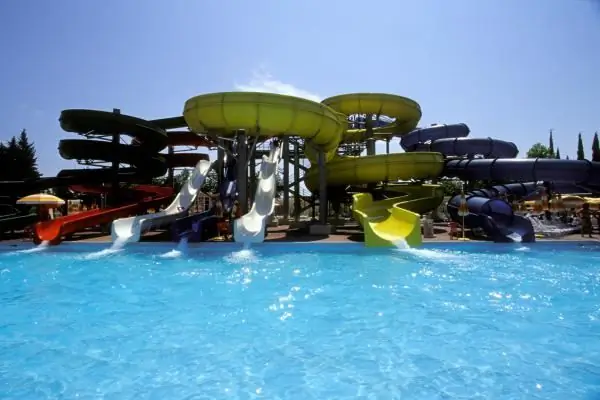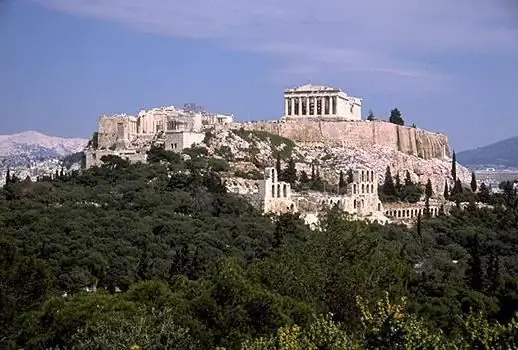- Author Harold Hamphrey [email protected].
- Public 2023-12-17 10:06.
- Last modified 2025-01-24 11:10.
Mount Lovcen Jezerski Verh is a place of pilgrimage for thousands of Montenegrins. And this is not surprising, since on its top is the mausoleum of Peter Negosh - a man who left a bright mark on the history and culture of the South Slavic peoples. The memory of him is dear to the inhabitants of Montenegro, who consider him their greatest poet and statesman.
Who is Piotr Negosh
Before talking about one of the most interesting sights of Montenegro, a few words should be said about the person who rests in it. Radivoi Tomov Petrovich was born in 1813 in the village of Negushi. Until the age of 12, the boy lived like ordinary peasant children and spent most of the day following a herd of sheep along the slopes of Mount Lovcen. There he got acquainted with folk songs, traditions and legends that local shepherds told him.

According to the old custom, the rulers of Montenegro had to be monks, so they did not have children. They passed their throne to their nephews. Radivoi's uncle was Metropolitan Peter the First Petrovich, the senior representative of the family. He decided to appoint his nephew as his successor. So Radivoj ended up in Cetinjemonastery and began to study science, preparing for the field prepared for him. After some time, he took the tonsure under the name of Peter, and after the death of the metropolitan in 1830, he ascended his throne. In 1833 he went on a trip to St. Petersburg, where he was ordained a bishop, and in 1844 - Metropolitan of Montenegro and Berdsk. Died of tuberculosis in 1851, aged 37.
Merit of Piotr Negosh
Few rulers managed to achieve such love and recognition from their people as this monk-poet. Throughout his short life, he fought for the independence of Montenegro from the Ottoman Empire and achieved the approval of the border with Austria. In addition, he advocated the unity of the southern Slavs and always had a pro-Russian orientation. It was Peter Negosh who founded the country's first printing school in Cetinje, and also became the author of many poetic works. His main merit was the proclamation of the independence of Montenegro, which saved its people from assimilation.

In 1845, shortly before his death, Peter II Petrovich-Njegosh bequeathed that he would certainly be buried in the chapel, founded by him on Mount Lovcen. The will of the metropolitan was not fulfilled, as his close associates were afraid that the grave of their ruler would be defiled by the Turks. To prevent this from happening, he was buried next to the grave of his predecessor, Peter the Great Petrovich. Only on August 26, 1855, the remains of the Metropolitan, in accordance with his last will, were transferred to Mount Lovcen. Before that, Prince Danilo of Montenegro opened the sarcophagus with his body to seewhether his remains decomposed, since their incorruptibility could be the reason for reckoning Peter Negosh to the canon of saints.
It turned out that there were no grounds for the canonization of the poet-metropolitan, and his ashes were finally buried in accordance with the will of the deceased. At the same time, despite the fact that many residents of Montenegro both then and today believe that Petr Negosh, like no one else, deserves to be recognized as a righteous man.

Further fate of the remains
In 1916, the command of the Austro-Hungarian army decided to destroy the chapel, in which the sarcophagus with the ashes of the famous fighter for the freedom of Montenegro, Petr Njegosh, was imprisoned. It was destroyed, and the remains were transferred to a relatively safer place - the Tsetinsky Monastery. On the site of the destroyed chapel, the winners planned to erect a monument glorifying the feat of the Austro-Hungarian soldiers who captured Lovcen. However, they did not even have time to start implementing this plan. After the end of the war, in the fall of 1925, the Montenegrins restored the chapel and a solemn procession, led by the Montenegrin Metropolitan and King of Croats, Serbs and Slovenes Alexander the First, transferred the remains of Peter the Second there in their arms. There they remained until April 1942, when the chapel was destroyed, now by Italian troops.
Negosh Mausoleum (Montenegro)
In 1951, in connection with the centennial anniversary of the death of Peter II Njegosh, the authorities of socialist Yugoslavia decided to demolish the chapel. Their goal was to build a completely new building in its place. MausoleumNjegoš was commissioned to design Ivan Meštrović, who had never been to Mount Lovcen. This plan aroused indignation among some Montenegrins, who rightly argued that the destruction of the chapel was contrary to the wishes of Njegos himself. Despite all the protests, in the late 1960s the chapel was destroyed, and by 1974 a mausoleum was built in its place, which still exists today.

In 1979, Montenegro suffered a serious natural disaster - a catastrophic earthquake, which caused a lot of destruction and casu alties on the territory of the republic. Many Orthodox believers believed that this event was a sign from above, meaning that the Lord was angry with their people, who destroyed an important national shrine and violated the last will of their national hero.
Description
The main attraction, thanks to which Mount Lovcen is famous, is the Negosh Mausoleum. It is built of stone and decorated with two large statues depicting women in Montenegrin national costumes. Some guidebooks claim that these are statues of the metropolitan's sister and mother. However, of course, this opinion is erroneous, since his parents had 5 daughters, and it is unlikely that the creators of the memorial would have depicted only one of them. As for the interior of the building, its sarcophagus is located on the lower floor, and on the upper floor there is a 28-ton statue of Peter Njegosh, carved from gray-green Jablanitsky granite. Its author is the sculptor Ivana Mestrovic. For his work, he asked for a very modest fee - a piece of uns alted sheep cheeseand the famous Negosh sprut (sun-dried ham). Above the head of the statue of the ruler, 3.74 meters high, an eagle spread its wings - a symbol of freedom-loving Montenegro.

Behind the mausoleum there is an observation deck with a view of the whole of Montenegro, and a tunnel leads to the monument, inside of which there is a steep "stairway to heaven", consisting of 500 steps.
Njegosh Mausoleum: how to get there
You can get to this memorial through Kotor or Cetinje, so many combine a visit to the tomb and an excursion to the residence of the Montenegrin metropolitans. There is another option that is suitable for hiking enthusiasts. They can leave the car at the Njegusi village and make the ascent to the mausoleum, which takes almost a whole day.
Please note that you have to pay 1 euro per car to enter Lovcen Park. At the same time, the cost of taxi services for a trip to the entrance to the tunnel leading to the Negosh mausoleum from Cetinje or Kotor will cost 20 euros.

Reviews
Most tourists who come to Montenegro tend to visit Negosh's mausoleum. Montenegro is a country where there are many attractions, however, according to travelers, nothing compares to the beauty of sunset or sunrise, which can be observed from the top of Lovcen, from where you can see Skopje, Skadar Lake and hundreds of picturesque mountain peaks touching the sky. In addition, many travelers enthusiastically express that they have been higherclouds, since one of the reasons that makes the Negosh mausoleum unique is its height above sea level, which is 1560 meters.
A few tips
Those who are going to visit the Negosh Mausoleum (see photo above) should listen to the recommendations of those who have already been there. First of all, they advise you to take warm clothes with you, even when it comes to climbing Mount Lovcen in the warm season. You should also stock up on drinking water and wear sports shoes. Experienced travelers recommend that tourists without appropriate physical training not try to take the mountain by storm, since this way you can quickly get exhausted and not enjoy the excursion. It is best to take short stops every 30 steps to catch your breath. In addition, you should not climb Lovcen in cloudy and windy weather, since in the first case you will not be able to admire the beauties of Montenegro, and in the second it will be extremely uncomfortable at the top.

Cetinj Monastery
Telling about the mausoleum of Negosh, it is also worth saying a few words about the monastery in which this famous ruler of Montenegro grew up and where his remains rested for many years. For more than 500 years, the residence of Montenegrin metropolitans has been located there. This monastery is closely connected with Russia and with its imperial house. At the monastery there is a museum in which the crown of St. Stefan Dechansky, ancient vestments of Montenegrin metropolitans, printed books and rare manuscripts of the 13th-19th centuries, ancient banners and church itemsutensils, many of which were donated by representatives of the Romanov dynasty.
Now you know where the mausoleum of Peter II Petrovich Negosh is located and how to get to it. Once in Montenegro, be sure to climb Lovcen to see this majestic structure and admire the natural beauties of ancient Montenegro from the top of the mountain.






